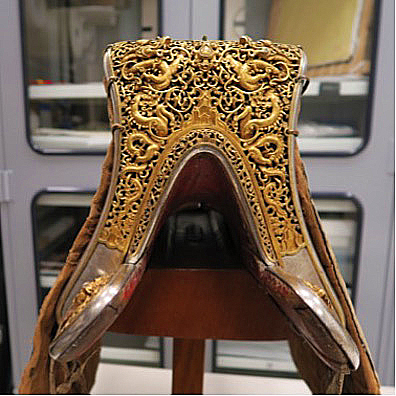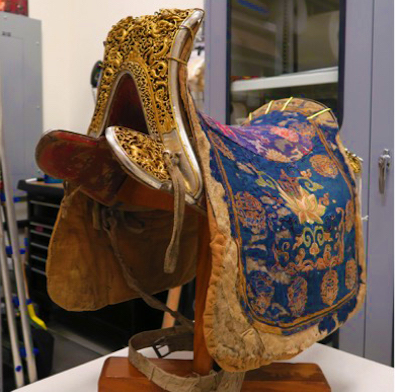
Before the days of Bentleys and Lamborghinis, the status symbols of choice were horse saddles and tack that were elaborately decorated to convey personal wealth. These were especially common tokens in Tibetan and Mongolian cultures, where large populations were nomadic and horses played an important role in everyday life. Saddles were also prominent items of use and trade along the silk route.
This beautifully adorned saddle is likely from Tibet or Mongolia and dates back to the 18th or 19th century. It is a prime example of how such objects were used to display affluence. The seven richly decorated face plates on this saddle are made from deeply chiseled iron and gilt with a technique known in the West as damasking. This involves crosshatched scoring of the metal for the overlaying of gold onto the roughened surface of iron, which is visible here in the dragon heads and jewel. According to the conservator who worked on this object, there is an unusually thick layer of gold, making this a very expensive luxury item. A number of towns in Derge (south-eastern Tibet), such as Horpo, were famous for both this damascening technique and pierced iron products, particularly saddles.

The motif seen here—scrollwork of long thin tendrils framing a pair of four-toed dragons facing a flaming jewel—is the most popular motif used to decorate Tibetan saddles. Notice the dragons’ heads at the top of the pommel are in dramatically higher relief, as if rising from the curving surface.
The seat and sides of the saddle are covered with an embroidered silk fabric, decorated with a large central lotus motif and smaller surrounding roundels with the Chinese character for long life (shou壽). The padding beneath the silk made of wool bunting is visible through wear in the silk.

There are a few details that provide a more specific sense of context for this saddle. In the center of the underside of the saddletree, the Tibetan letter ka is branded into the wood on the underside (see detail), likely serving as a kind of inventory number. Just above it is a vertical Mongolian word jai, which means gap or space, written in black ink. Tibetan letters are sometimes used as brands on Mongolian horses, which together with the Mongolian script, suggests Mongolian ownership, if not manufacture at some point in the object’s history.

This saddle is quite close in comparison to a saddle in the Metropolitan Museum of Art, which is attributed to “Chinese for the Tibetan Market, 17th-18th century” and can be viewed here. Both saddles boast a blue silk cover, which suggests ownership by a lay nobleman, as opposed to a religious figure who would have had a yellow silk cover. In addition to similarities in shape, adornment, and construction, the Met saddle interestingly also has the same Tibetan letter branded into the wood of the underside of the saddle tree. This is a suggestive detail that warrants further exploration.
This object was a recent gift of the family of Leon J. Weil, who was a former ambassador to Nepal (1984-87). The object is on view for the first time at the Rubin Museum in our current exhibition Masterworks: Jewels of the Collection.

